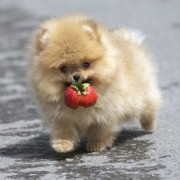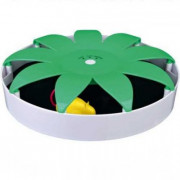Exo terra
Содержание:
Kinyongia vanheygeni

Holotype:
ZFMK 88383, subadult male, coll. by native farmers, spring of 2005, Poroto Mountains, southern Tanzania, approx. 9°0’S, 33°45’E.
none.
Comparative material:
1. verbal description (Nagy in verb.),
2. photographic record of an adult by Emmanuel Van Heygen, November 2008, Ngozi Forest (9°1’39.87″S, 33°33’54.21″E), Poroto Mts., southern Tanzania.
Diagnosis:
Total length about 15 cm; tail distinctly longer than SVL; scutellation of body slightly heterogenous, homogenous on limbs and tail; head relatively long, with a distinct casque that rises only behind the orbits in the form of an arched parietal crest and clearly exceeds the level of the dorsum; rostral projection with two parallel longitudinal dorsal rows of 3 enlarged conical scales each by which this species is distinct from all other known Kinyongia.
Description of holotype:
Total length 128 mm, tail (tip missing) 67 mm, SVL 61 mm; scutellation of body subheterogenous, scales on flank relatively small, round, subhomogenous, arranged in roundish to oval patches of 8-12 each; patches regularly arranged, separated by wide zones of interstitial skin, forming reticulated pattern; scales on limbs, tail and throat homogenous, with scales on limbs being larger than those on flanks, and those on fore limbs being slightly larger than those on hind limbs; subcaudals rectangular, arranged in distinct rows across; gulars homogenous, arranged in longitudinal rows, separated by 5-6 strips of interstitial skin; no dorsal crest, merely a twin row of undifferentiated dorsal scales; no gular or ventral crests; head 11 mm in width, 2.33 times longer than wide, with a moderately high casque (for measurements see Table 1); no occipital lobes; parietal crest initially low, rising only from about halfway between orbits and peak of casque, covered with enlarged, laterally compressed scales, rising 3.2 mm above level of dorsum; casque and temporal region with much enlarged flattened scales; lateral crest of enlarged warty scales; canthi rostrales meeting above tip of snout and forming a rostral horn that extends beyond the tip of the snout (by 2.5 mm); canthi rostrales not fused, but each ending with a blunt, conical scale, leaving a concave gap between them; rostral horn with 2 dorsal parallel longitudinal rows of 3 enlarged conical scales each, providing it with a serrated look in lateral view; eyelids with homogenous, small scales; nostril at halfway point betw. anterior margin of orbit and tip of snout; no temporal crest.
Table 1

* Measurements were taken from the photographs available and calculated relative to the known snout-vent length (66 mm);
** Tip of tail missing

Named after Emmanuel Van Heygen of Belgium who took the first photographs of the new species in the wild.
Unknown outside type locality, but probably very limited.

Cladistic relationships:
Not researched; small size might indicate affinity to K. tenuis and K. oxyrhina (see Table 2), or shape of rostral projection might point to K. uthmoelleri (see Table 2); shape of rostral horn might represent original evolutionary stage as it also appears like this in juvenile K. boehmei males.







